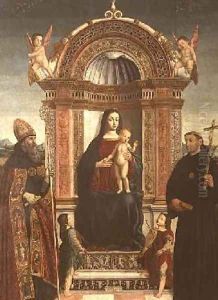Bernardino Loschi Paintings
Bernardino Loschi was an Italian painter of the Renaissance period, active mainly in his hometown of Vicenza in the Veneto region, as well as in other nearby cities. While his exact date of birth is not known, most sources suggest that he was born around 1450. Loschi is often considered to be a part of the Vicentine school of painting, which was influenced by both the Venetian and Paduan artistic traditions.
Little is known about Loschi's training, but it is believed that he may have been a student of Bartolomeo Montagna, another prominent painter from Vicenza. Loschi's work is characterized by its strong narrative quality and his adept use of color and light, which he likely developed under the influence of the Venetian school. Despite the lack of extensive documentation, his paintings suggest a solid understanding of the developments in Renaissance art, as well as an individual approach to composition and subject matter.
Loschi's artistic output includes altarpieces, frescoes, and panel paintings. Among his notable works is the fresco cycle in the Dome of Vicenza, where he painted scenes from the life of the Virgin and other religious subjects. Another important work is his contribution to the decoration of the Palazzo Thiene in Vicenza, where he worked alongside other artists such as Giovanni Speranza and Giovanni Maria Falconetto.
Despite his contributions to the art of the Veneto region, Bernardino Loschi has not received the same level of recognition as some of his contemporaries. His death is recorded in 1529, and while he may not be as well-known as artists like Titian or Bellini, his work provides valuable insight into the regional variations of Italian Renaissance painting and the interplay between different artistic centers in Northern Italy. Today, Loschi's works can be found in various churches and museums, helping to shed light on the diversity of Renaissance art beyond the major centers of Florence, Rome, and Venice.
